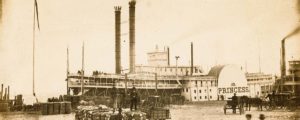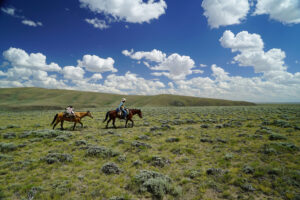Laws, California, was built in anticipation of a railroad— the narrow-gauge Carson & Colorado to be exact. The Carson & Colorado Railroad Co., formed on May 10, 1880, envisioned its line running from Mound House, Nevada, on the Carson River, to the Colorado River. By the time the tracks arrived in California’s Owens Valley three years later, the budding settlement—then known simply as Station— comprised a depot, an agent’s house, a section supervisor’s house, a water tank, a railway turntable and outhouses. Other structures soon followed, including homes, two general stores, a hotel, a boardinghouse, a blacksmith’s shop, a dance hall, a barbershop, warehouses and (in 1887) a post office.
The 300-mile C&C railroad never did reach the Colorado, but it provided a boost to Station and environs, shipping livestock and crops from local ranches and ore from district mines. In 1900 the C&C sold the line to the Southern Pacific Railroad, which changed the town’s name to honor longtime Southern Pacific superintendent R.J. Laws. The town of Laws became the main shipping point for supplies to such Nevada gold boomtowns as Tonopah and Goldfield.
Laws remained a close-knit, solid community for another half-century. Its decline in the 1950s was attributed to, among other things, the closure of local mines and the lower cost of shipping by truck vs. rail. By 1959 it was virtually a ghost town. The last train left the depot on April 30, 1960, and soon after Southern Pacific officials presented a gift deed to Inyo County and the city of Bishop for “steam locomotive No. 9 together with other rolling stock and the Laws station building and surrounding installations for safekeeping in behalf of generations to come.”
With a groundswell of public support the Bishop Museum and Historical Society purchased additional land for an outdoor museum to preserve the area’s railroad era. The society saved the few remaining buildings in the town of Laws and moved in other historic buildings from around the Owens Valley to recreate the village. Film crews working on the 1966 Western Nevada Smith, starring Steve McQueen, shot at various locations in the Owens Valley and Inyo National Forest, using Laws as a set and building additional structures.
As the Laws Railroad Museum and Historic Site took shape, several old-timers visited to share their memories—a retired engineer stood beside locomotive No. 9 and envisioned his hand “on the throttle”; an elderly couple remembered the day the man greeted his bride-to-be at the depot; an old sheep rancher described loading his “woollies” onto train cars; and a former cattle rancher recalled the sound of the train whistle blowing once his stock was all aboard.
The main attraction at the site remains the trains. Parked on the tracks beside the original 1880s depot is the 1909 Baldwin 4-6-0 steam locomotive No. 9. Visitors are encouraged to climb into the cab and ring the bell. Trailing behind are several freight cars and an 1883 C&C caboose. Another intriguing railcar on display is the 1929 self-propelled Brill Co. car, donated by the Death Valley Railroad and fully restored in 2004. Summer visitors can hop aboard and ride the historic train.
The village holds its own appeal. Near the depot are the original agent’s house, water tank and oil tank, as well as the working turntable. Stroll farther into town to find the post office, a general store and a saloon, to name just a few of the historic buildings. In all you’ll find more than 30 structures, including an icehouse from Bishop, an early gas station and its pumps, the 1909 North Inyo schoolhouse and Bishop’s first Catholic church. At the east end of town, nestled amid a grove of trees, are several small restored Victorian homes, which house exhibits of 19th-century clothing, appliances, musical instruments, children’s toys and other artifacts.
The Laws Railroad Museum & Historic Site, off U.S. Highway 6 in Inyo County, 5 miles from U.S. 395, is open year-round. For more information call 760-873-5950 or visit www.lawsmuseum.com.
Originally published in the June 2015 issue of Wild West. To subscribe, click here.




